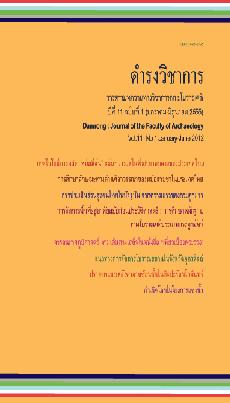DOMESTIC SPACE MANAGEMENT DURING THE PREHISTORIC PERIOD: A STUDY OF ARCHAEOFAUNAL REMAINS
Keywords:
สมัยก่อนประวัติศาสตร์, กระดูกสัตว์Abstract
The main objectives of this study are to analyze the distribution patterns of the Late Pleistocene faunal remains and to interpret the way prehistoric people utilized domestic space in their domestic activity areas at Tham Lod rockshelter. Results from the analysis show that the Late Pleistocene hunter-gatherers who occupied the rockshelter had specific behaviour regarding site/domestic space management, as follows:
1. The Late Pleistocene hunter-gatherers divided their domestic space into 3 distinct areas: a household area, a communal area, and a special activity area.
2. Evaluating space utilization indicates that they paid particular attention to a comfortable sleeping area.
3. Their refuse disposal patterns indicate that the site had probably been used several times by the Late Pleistocene hunter-gatherers as a temporary camp site, and that they had no specific space for refuse disposal.
This domestic space management had developed through time. It is assumed that the hunter-gatherer groups who occupied this site through the Late Pleistocene period might share the same way of thinking in terms of site/domestic space management. Moreover, they could possibly be the same cultural group.
References
รัศมี ชูทรงเดช และคณะ. “รายงานวิจัยฉบับสมบูรณ์โครงการโบราณคดีบนพื้นที่สูงในอําเภอปางมะผ้า จังหวัดแม่ฮ่องสอน (เล่มที่ 5: การขุดค้นแหล่งโบราณคดีเพิงผาถ้ำลอด).” กรุงเทพฯ: สํานักงานกองทุนสนับสนุนการวิจัย, 2546.
_______. “รายงานวิจัยฉบับสมบูรณ์โครงการโบราณคดีบนพื้นที่สูงในอําเภอปางมะผ้า จังหวัดแม่ฮ่องสอน ระยะที่ 2 (เล่มที่ 2: ด้านโบราณคดี).” กรุงเทพฯ: สํานักงานกองทุนสนับสนุนการวิจัย, 2550.
อุดมลักษณ์ ฮุ่นตระกูล. “รายงานวิจัยฉบับสมบูรณ์โครงการโบราณคดีบนพื้นที่สูงในอําเภอปางมะผ้า จังหวัดแม่ฮ่องสอน ระยะที่ 2 (เล่มที่ 6: การศึกษาชาติพันธุ์วรรณนาทางโบราณคดี).” สํานักงานกองทุนสนับสนุนการวิจัย, 2550.
Bartram, L.E., Kroll, E.M. and Bunn, H.T. “Variability in Camp Structureand Bone Food Refuse Patterning at Kua San Hunter-GathererCamps.” In The Interpretation of Archaeological Spatial Patterning. Edited by Kroll, E.M. and Price, T.D. United State of America: New York. Plenum Press, 1991.
Binford, L. R. Nunamiut Ethnoarchaeology. Academic Press, New York, 1978
Clarke, D. L. Spatial Archaeology. Boston: Academic Press, 1977.
David, N. and Kramer, C. Ethnoarchaeology in Action. United Kingdom: Cambridge University Press, 2001.
Fagan, B. M. Archaeology : A Brief Introduction. 9th ed., New Jersey: Upper Saddle River, 2006.
Galanidou, N. “Patterns in caves: foragers, horticulturists and the use of space.” Journal of Anthropological Archaeology 19 (2000): 243–75.
Joyce, A. and Johannessen, S. “Abandonment and the production of archaeological variability at domestic sites.” The Abandonment of Settlements and Regions: Ethnoarchaeological and Archaeological Approaches. Edited by Catherine M. Cameron and Steve A. Tomka. University of Colorado, Boulder, 1993.
Murray, P. “Discard location: The ethnographic data.” American Antiquity 45 (1980): 490 - 502.
O’Connell, J.F., Hawkes, K. and Jones, N.B. “Distribution of Refuse-Producing Activities at Hadza Residential Base Camps: Implications for Analyses of Archaeological Site Structure.” The Interpretation of Archaeological Spatial Patterning. Edited by Kroll, E.M. and Price, T.D. United State of America: New York. Plenum Press, 1991.
Renfrew, C. and Bahn, P. Archaeology: Theories, Methods, Practice. New York: Thames and Hudson Inc, 1996.
Schiffer, M. B. “Archaeological context and systemic context.” AmericanAntiquity 37 (1972): 156-165.
________. “Toward the Identification of Formation Processes.” American Antiquity 48 (1983): 675-706
________. Formation Processes of the Archaeological Record: Formation Processes of the Archaeological Record. Albuquerque: University of New Mexico Press, 1987.
Spurling, B. and Hayden, B. “Ethnoarchaeology and intrasite spatial analysis: a case study from the Australian Western Desert.” In Intrasite spatial analysis in archaeology. Edited by Harold Hietala. Cambridge University: Cambridge, 1984.
Downloads
Issue
Section
License
บทความนี้เป็นผลงานของข้าพเจ้าแต่เพียงผู้เดียว และ/หรือเป็นผลงานของข้าพเจ้าและผู้ร่วมงาน ตามชื่อที่ระบุในบทความจริง และเป็นผลงานที่มิได้ถูกนำเสนอหรือตีพิมพ์ที่ใดมาก่อน




